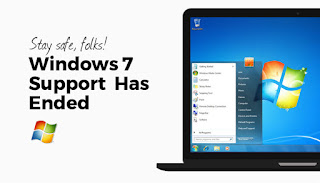Support for Windows 7 has ended

After 10 years, support for Windows 7 ended on 14 January 2020. We know change can be difficult, so we are here to help you with recommendations for what to do next and to answer questions about end of support. What does end of support mean? As of 14 January 2020, your computer running Windows 7 will still function but Microsoft will no longer provide the following: Technical support for any issues While you could continue to use your PC running Windows 7, without continued software and security updates, it will be at greater risk for viruses and malware. Going forward, the best way for you to stay secure is on Windows 10. And the best way to experience Windows 10 is on a new PC. While it is possible to install Windows 10 on your older device, it is not recommended. Support for Windows 7 without Service Pack 1 ended on April 9, 2013, requiring users to update in order to continue receiving updates and support after 3 years, 8 months, and 18 days. Microsoft ended the sale of new retai

